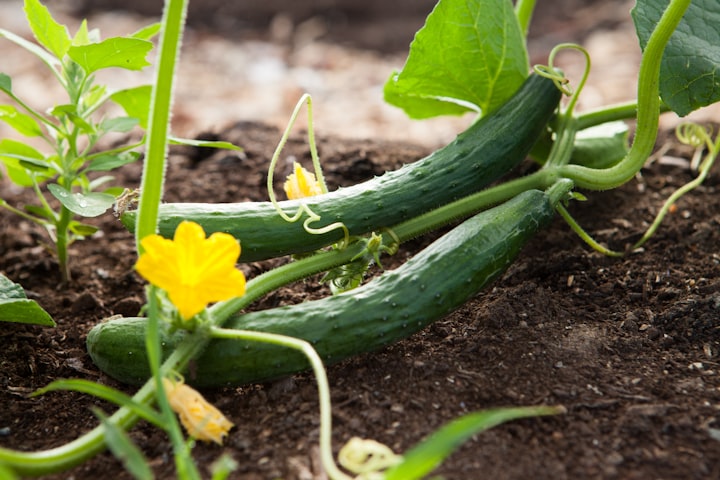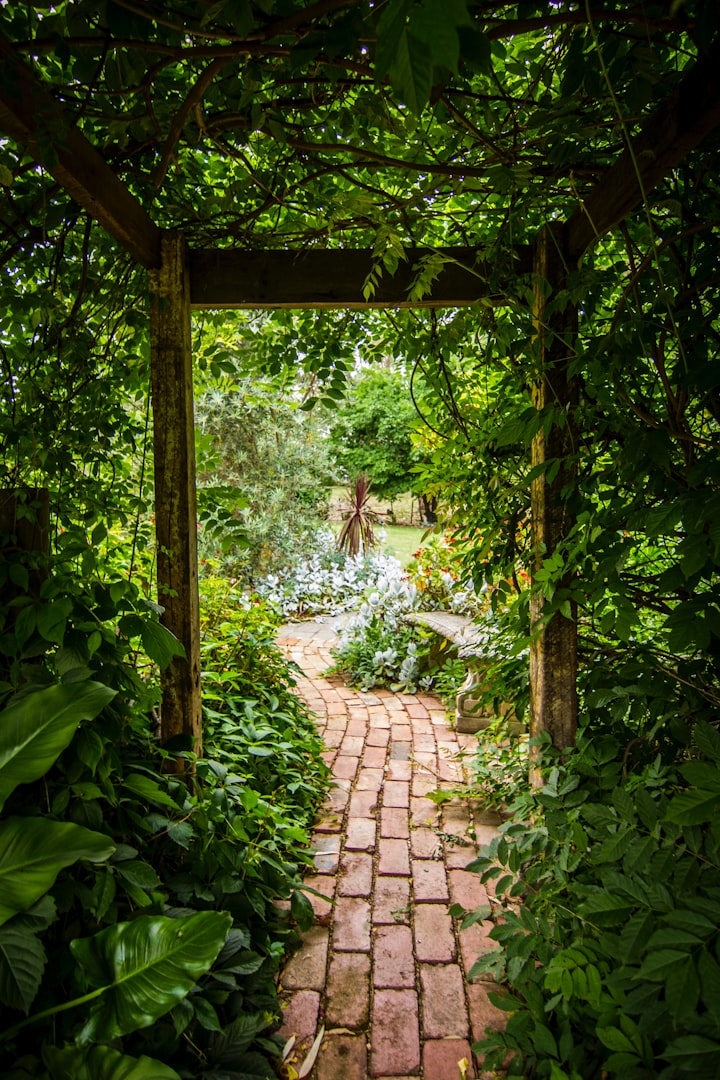Climbing Colossal Cucumbers
Although cucumbers, like other vining plants, require a lot of room to grow, they can still be accommodated in a small garden plot by training the vines to attach to a supporting trellis.

Cucumber Trellis
By: Marlene Affeld
I love growing fresh cucumbers in my country garden and enjoy having plenty for salads as well as pickling. Most seasons, I have lots left over to share with friends and family or to sell at the fresh market.

Native to India, cucumbers are members of the cucurbit plant family, the same as gourds, squash, and pumpkin. Cucumbers are generally eaten raw or pickled. Planted in late spring and harvested throughout the summer, cucumber plants do not tolerate dampness or cold soil. Cucumbers thrive in United States Plant Hardiness Zones 3 through 9.

Cucumbers are one of the most popular vegetables cultivated in both urban and rural homestead gardens. There are two different types of cucumbers, the long dark green cucumbers used for fresh slicing and the shorter blunt-end cucumbers most suited to pickling. There are dozens of different varieties of cucumbers, including lemon cucumbers.
Support Trailing Garden Plants
Cucumbers love to climb: trellising increases crop production. Trailing or vining plants like cucumbers produce better quality fruit with less disease or damage when supported on sturdy trellising. If you plan to sell your cucumbers at the fresh market, you want firm skinned “cukes” without discoloration, bruising, or spoilage.
• Supporting the vines and fruit up off of the soil is the best way to avoid yellowed, bleached, bruised, or misshapen fruit.
• If cucumbers are allowed to sit on the ground, they can begin to rot.
• A raised trellis makes the harvest process a lot easier.
Growing Cucumbers
Cucumbers, like most vining or trailing plants, grow best in a full-sun location with nutrient-rich, well-drained soil and plenty of moisture. Cucumbers require at least one-inch of water a week, but cannot live in soggy ground.

Cucumbers are excellent companion plants for radishes, beans, sunflowers, beans, beets, peas, and carrots. Avoid planting cucumbers in close proximity to potatoes or fragrant herbs.
Prepare The Soil
Before planting, enhance the soil with a generous amount of garden compost or aged herbivore manure (cow, sheep, goat, horse, llama,) Cumbers thrive in soil with a pH of 6.0 –to- 6.5. If you are planting a sizeable area in cucumbers, it is wise to do a soil test. You do not want to over-fertilize cucumber plants. If the nitrogen level in the soil is excessive, you will end up with “leggy” vines and slow fruit production.
Plant cucumber seeds when the soil warms in the spring. Soil temperature should be 60 degrees Fahrenheit or above for ideal germination. When growing cucumbers, it takes 50-to-70 days of sunny weather to reach harvest.
Planting and Spacing
Cucumber seeds can be started indoors or planted directly into the soil. Space tender young seedlings about 18-to-24-inches apart, in rows, spaced 3 feet apart. All members of the cucurbit family suffer shock from transplanting. If you start seeds indoors, it is wise to use biodegradable seed pots, which are planted directly into the soil. This will prevent damage to delicate roots and help the plant avoid the shock of transplant.

Like pumpkins, squash, and other members of the cucurbit family, cucumbers present two kinds of flowers: male (staminate) and female (pistillate.) Male flowers fall from the vine and do not produce fruit. Their only purpose is to provide pollen for the female flowers. Each flower only blooms for one day.
• It requires a lot of bees to pollinate the plants. Commercial cucumber growers advise that for cucumbers and other fruit and flowering vegetable crops requiring pollination, 2-to-3 beehives per acre are essential to encourage pollination.

For cucumbers, adequate pollination is essential: insufficient seed development causes misshapen, curved, short, or aborted fruit.
Although cucumbers are easy to grow, without support and direction, the vines can quickly over-run the garden, wandering totally out of control. A strong and sturdy trellis solves the problem, keeping plants healthy, attractive, and productive.
Provide Support
A lean-to or A-frame designed trellis is ideal for maximizing garden space and can be used in-ground or in raised beds. When using a lean-to design, you can plant radishes of salad greens under the trellis for a second crop before the cucumbers mature. A wide array of sturdy metal or plastic lattice, available for purchase online or at home and garden centers, is the easiest way to protect your “cukes.” However, if you are a handy homesteader, you can make a garden trellis from salvaged materials at little or no cost.

• Because I am frugal and prefer a “natural look” in my garden, I prefer to make a trellis, garden stakes and support posts from driftwood I gather at the river. If you use driftwood in your garden, keep in mind that it is best to avoid saltwater driftwood that can leach salt into the soil.
• Weave a driftwood and hemp cord hanging “ladder” to support vining plants. You can use lengths of driftwood or fallen branches, bamboo or wooden dowels. It is fun to use your imagination to craft attractive yet highly functional support to hang from a tree or against a building or fence.
• You likely have some old cattle panels lying about in the barn, or they are available online or from a local farm and feed store. Cattle panels are relatively inexpensive galvanized fencing for livestock, ideal for supporting vining garden crops. The expansive grids allow for ease in harvesting. Cattle panels can be employed vertically, horizontally, assembled as an arch, or an A-frame trellis. To make the most of garden space, a second companion planting of peas, beans, or melons will do well growing on the same grille. The tendrils of the plants grab hold of the wire, securing the vine to the trellis as they grow.
• If you grow bush cucumbers, you can easily make a 3 or 4- legged “teepee” support for your plants with bamboo, willow stakes, lengths of plastic pipe, or freshwater driftwood. Bush cucumbers flourish when planted in large pots or containers. Make sure the container has excellent drainage and is positioned in a full-sun location.

• The plastic-coated rack shelving from an old refrigerator, tied to wooden posts staked in the soil, offers excellent support for many garden vining plants, including cucumbers, gourds, and tomatoes.
• Plant cucumbers along the base of a rock wall or along a fence line. Train the vines to trail and attach to the rock face for an attractive backdrop to the bold green color of the cucumber plants.
• Plant cucumbers in pots or containers located in a sunny location. Position containers where vines can trail on a fence, tree stump, balcony rail, or light post. Cucumbers can also be trellised on a gazebo or covered garden swing.

• Think of innovative ways to recycle using broken farm tools, a rusty wheel barrel, or use an old ladder that has gotten a bit “wobbly” as support for cucumbers or other vining vegetables.
• Create a simple framework with horizontal support out of branches or boards. Cover with chicken wire for a lightweight, easy-to-make trellis. Gardeners, with raised beds, can add a post to each corner of the bed and then string garden twine or wire to create a supporting grid.
• Craft a sturdy box canopy frame with plastic pipe. Cumbers can trail up the pipes, and you can add cross shelving for potted plants. The cucumber flowers attract bees and other beneficial pollinators to the garden, and the shelving is a great way to maximize space.
• Hog wire, metal stakes, or any fencing material leftover from previous homestead projects can be utilized in ingenious ways when it comes to cultivating cucumbers.
• Children love to plant cucumbers and watch them grow: the seeds are large enough that they are easy to handle, and the plant responds to frequent watering. Plant cucumbers where they can trail on a swing set or playground equipment.

Harvesting Cucumbers
Garden crops like cucumbers are pollinated by bees at different times, creating multiple harvests throughout the growing season. To capture the best cucumber crispness, flavor and firmness, harvest when fruits are about 6-inches long and less than 2-inches in diameter.
Use a sharp, sterile knife when cutting the fruit from the vine. Store cucumbers in a cool, humid place, preferably under refrigeration. It is best to chill cucumbers immediately after picking to remove field heat, protect flavor, and extend shelf life. Do not wash cucumbers before storage. You can store cucumber in plastic bags or wrapped in plastic to preserve their moisture content.
References:
United States Department of Agriculture – Cucumbers
https://nifa.usda.gov/sites/default/files/resource/Cucumbers%20Good%20Agricultural%20Practices%20508.pdf
The University of Georgia Extension – Growing Cucumbers In The Home Garden
http://extension.uga.edu/publications/detail.html?number=C1034&title=Growing%20Cucumbers%20in%20the%20Home%20Garden
Oregon State University Extension – Wait Until Soil Warms To Plant Cucumbers
https://extension.oregonstate.edu/news/wait-soil-warm-plant-cukes
United States Department of Agriculture – Planting In A High Tunnel
https://www.nrcs.usda.gov/Internet/FSE_DOCUMENTS/stelprdb1261943.pdf
About the Creator
Marlene Affeld
“A passionate writer for more than 30 years, Marlene Affeld’s passion for the environment inspires her to write informative articles to assist others in living a green lifestyle.”






Comments
There are no comments for this story
Be the first to respond and start the conversation.